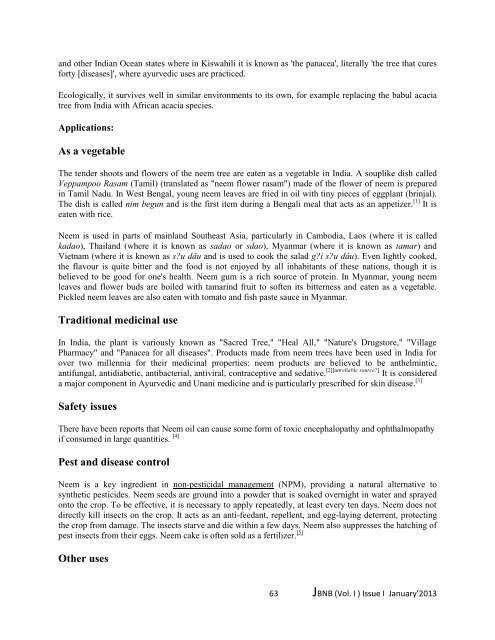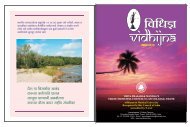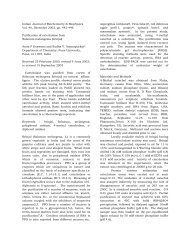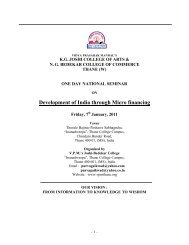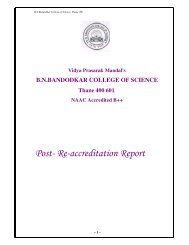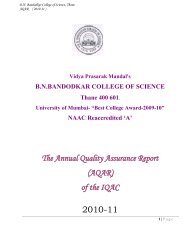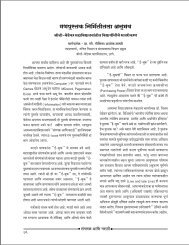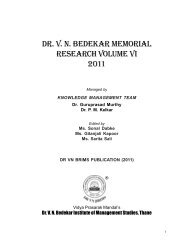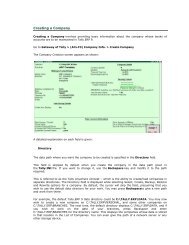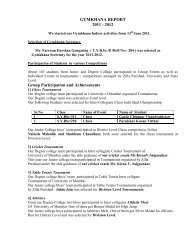J-BNB - VPMThane.org
J-BNB - VPMThane.org
J-BNB - VPMThane.org
You also want an ePaper? Increase the reach of your titles
YUMPU automatically turns print PDFs into web optimized ePapers that Google loves.
and other Indian Ocean states where in Kiswahili it is known as 'the panacea', literally 'the tree that cures<br />
forty [diseases]', where ayurvedic uses are practiced.<br />
Ecologically, it survives well in similar environments to its own, for example replacing the babul acacia<br />
tree from India with African acacia species.<br />
Applications:<br />
As a vegetable<br />
The tender shoots and flowers of the neem tree are eaten as a vegetable in India. A souplike dish called<br />
Veppampoo Rasam (Tamil) (translated as "neem flower rasam") made of the flower of neem is prepared<br />
in Tamil Nadu. In West Bengal, young neem leaves are fried in oil with tiny pieces of eggplant (brinjal).<br />
The dish is called nim begun and is the first item during a Bengali meal that acts as an appetizer. [1] It is<br />
eaten with rice.<br />
Neem is used in parts of mainland Southeast Asia, particularly in Cambodia, Laos (where it is called<br />
kadao), Thailand (where it is known as sadao or sdao), Myanmar (where it is known as tamar) and<br />
Vietnam (where it is known as su dâu and is used to cook the salad gi su dâu). Even lightly cooked,<br />
the flavour is quite bitter and the food is not enjoyed by all inhabitants of these nations, though it is<br />
believed to be good for one's health. Neem gum is a rich source of protein. In Myanmar, young neem<br />
leaves and flower buds are boiled with tamarind fruit to soften its bitterness and eaten as a vegetable.<br />
Pickled neem leaves are also eaten with tomato and fish paste sauce in Myanmar.<br />
Traditional medicinal use<br />
In India, the plant is variously known as "Sacred Tree," "Heal All," "Nature's Drugstore," "Village<br />
Pharmacy" and "Panacea for all diseases". Products made from neem trees have been used in India for<br />
over two millennia for their medicinal properties: neem products are believed to be anthelmintic,<br />
antifungal, antidiabetic, antibacterial, antiviral, contraceptive and sedative. [2][unreliable source] It is considered<br />
a major component in Ayurvedic and Unani medicine and is particularly prescribed for skin disease. [3]<br />
Safety issues<br />
There have been reports that Neem oil can cause some form of toxic encephalopathy and ophthalmopathy<br />
if consumed in large quantities. [4]<br />
Pest and disease control<br />
Neem is a key ingredient in non-pesticidal management (NPM), providing a natural alternative to<br />
synthetic pesticides. Neem seeds are ground into a powder that is soaked overnight in water and sprayed<br />
onto the crop. To be effective, it is necessary to apply repeatedly, at least every ten days. Neem does not<br />
directly kill insects on the crop. It acts as an anti-feedant, repellent, and egg-laying deterrent, protecting<br />
the crop from damage. The insects starve and die within a few days. Neem also suppresses the hatching of<br />
pest insects from their eggs. Neem cake is often sold as a fertilizer. [5]<br />
Other uses<br />
63 J<strong>BNB</strong> (Vol. I ) Issue I January’2013


